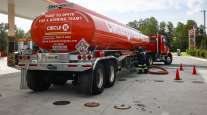Editorial: Fuel Prices and Fleet Failures
The latest quarterly study of trucking fleet failures paints a more positive picture than we would have expected in years past, considering the high level of fuel prices.
The study found that 160 motor carriers closed their doors during the year’s first three months, compared with 295 in the same period of 2011, even though the average cost of a gallon of diesel rose 37 cents during that time.
In the past, the fleet failure rate closely tracked the cost of diesel.
The industry this year, however, apparently benefited from a number of events: While fuel rose in the quarter, the increases were relatively orderly; used truck prices have strengthened; and cargo capacity is approximately in sync with freight demand.
Fleets have gotten better at recouping some of the money lost to rising fuel prices, as they’ve refined the surcharge process for their customers.
Also, when prices move in a less volatile manner, fleets don’t have to finance the cost of fuel spikes while they await payment from customers.
The rising value of used equipment has also helped, as teetering fleets are able to sell their businesses off to competitors who are hungry for additional equipment and the drivers to operate it.
Fleet failures skyrocketed during the recession, as used equipment prices tanked and an oversupply of vehicles overwhelmed the market.
For instance, in the second quarter of 2008, fleet failures peaked at 970, when diesel prices reached a peak of $4.427 per gallon and freight was getting scarce.
By comparison, even though the price of fuel has risen since the year began, the national average diesel retail price is currently $4.073, after dipping for three consecutive weeks.
These days, healthier fleets are often happy to acquire a failing competitor in order to add the trucks and drivers to their rosters.
Healthy fleets are willing to expand these days because freight rates have been relatively strong, even though the pace of economic recovery in the United States has been reasonably slow.
And those strong rates have come as the result of the rebalancing of freight capacity and freight demand, as carriers matched their regrowth to the pace of the recovery. And the low fleet failure rate in the first quarter is another sign of the relative health of our industry.
Now, if we could only get the economic recovery moving a little faster...




